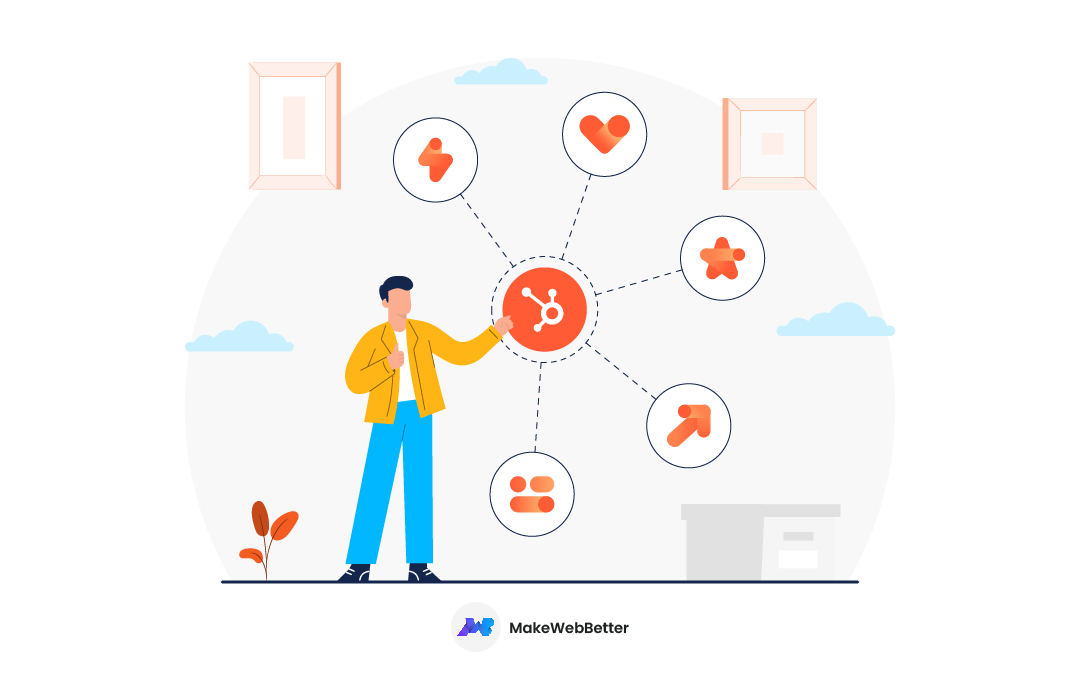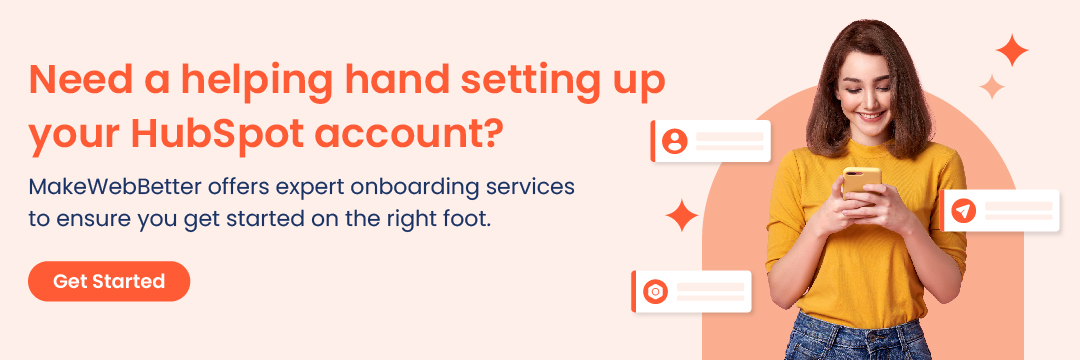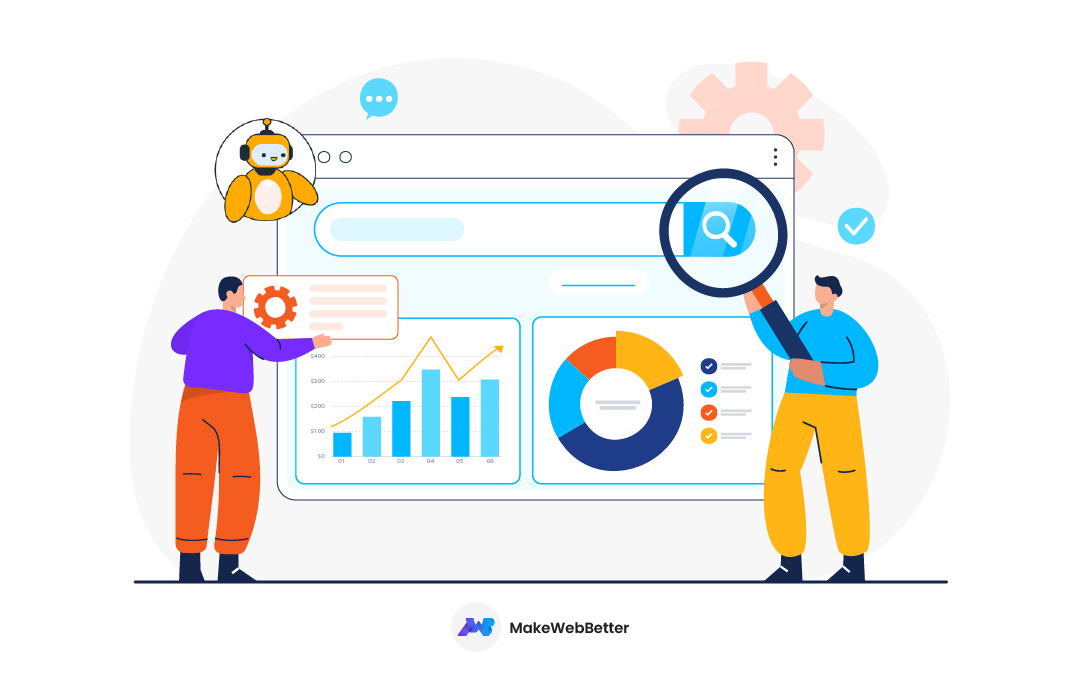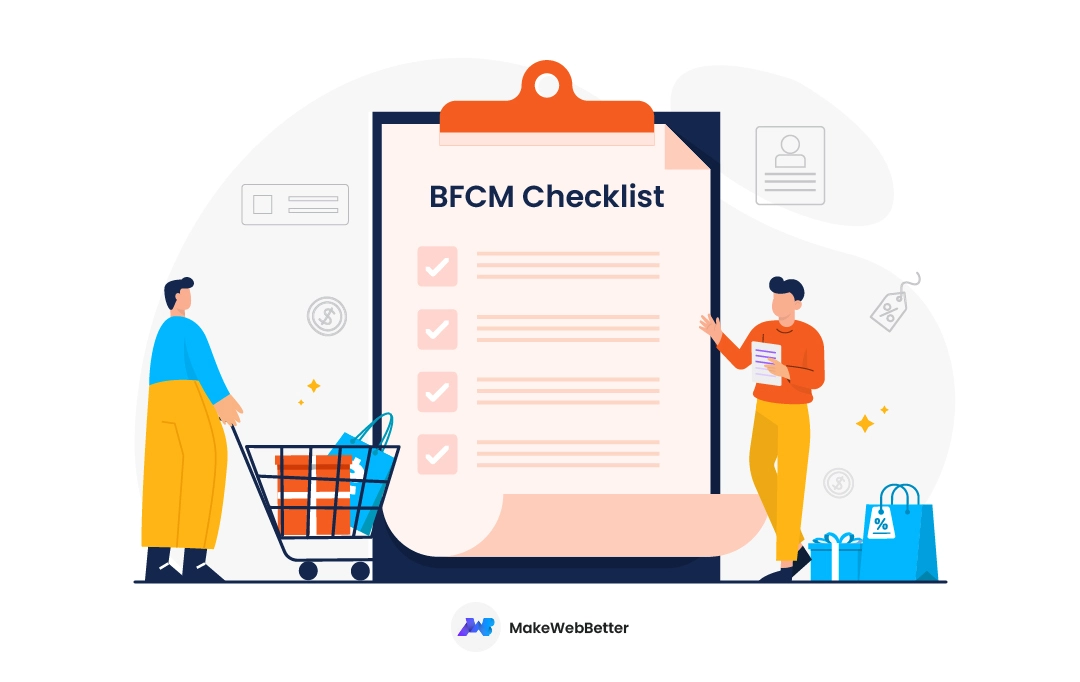Abandoned Carts and Lost Sales? The eCommerce Cure Awaits
Imagine this: a customer visits your online store, browses through products, adds items to their cart, but then…abandons it.
Frustrating, right?
In today’s competitive ecommerce landscape, keeping customers engaged throughout their buying journey is crucial for success. And that’s where HubSpot integration for ecommerce comes in, so let’s learn more about it.
Introducing Your Customer Engagement Powerhouse: CRM
A Customer Relationship Management or CRM system acts as your central hub for all customer interactions, allowing you to:
- Consolidate customer data: Eliminate scattered spreadsheets and fragmented information.
- Personalize the customer journey: Tailor interactions based on individual preferences and buying behavior.
- Streamline sales processes: Automate tasks, nurture leads, and close deals efficiently.
Boost Sales, Build Loyalty, and Streamline Operations with HubSpot CRM
By implementing a CRM like HubSpot CRM, you can unlock a powerful set of tools designed specifically to address the unique needs of HubSpot integration for ecommerce businesses.
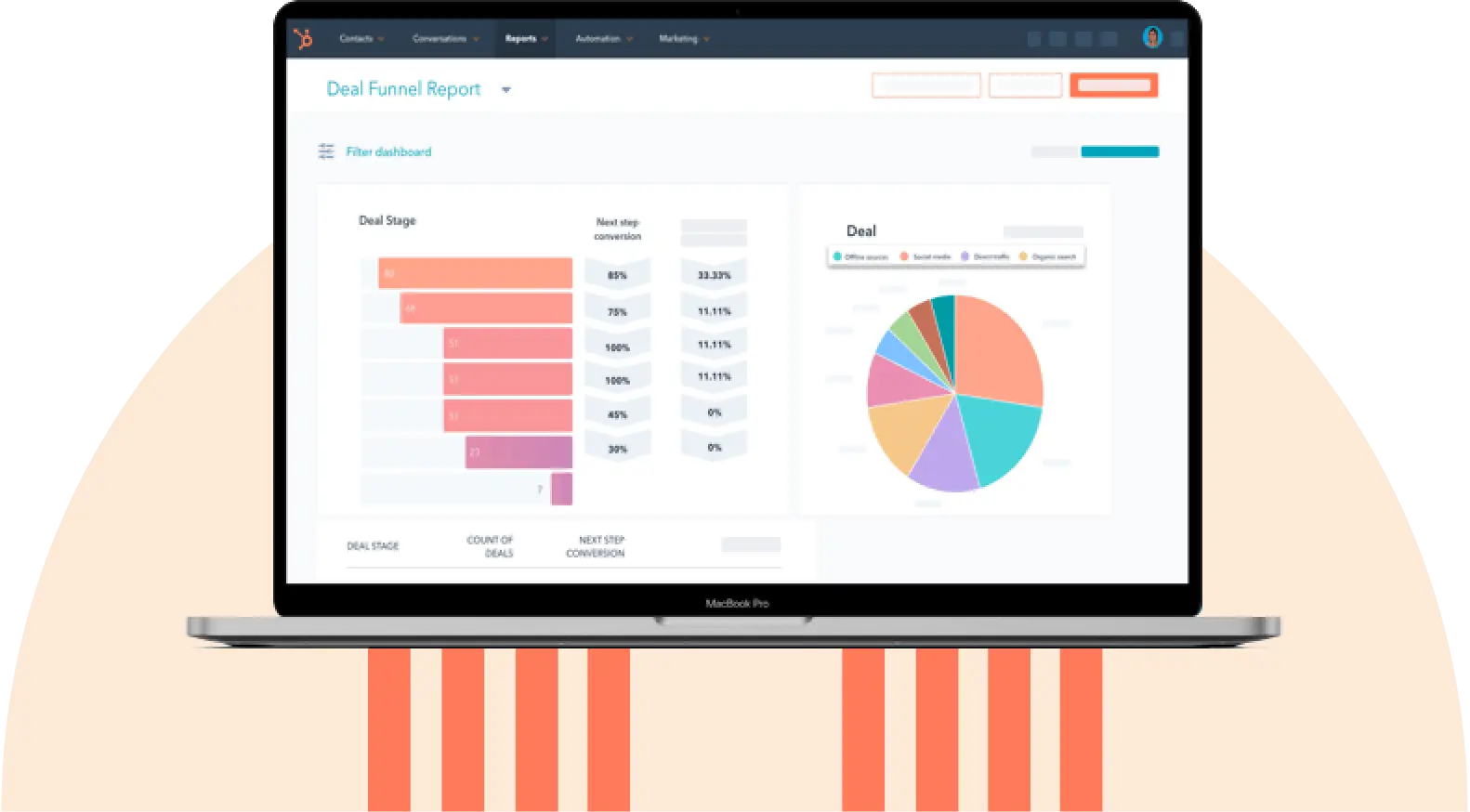
That is to say, this translates to:
- Increased sales: Did you know that about 78% of sales leaders confirmed that CRM tools like HubSpot Integration for eCommerce boosted their sales dramatically. So, convert more visitors into customers with targeted marketing and personalized communication.
- Enhanced customer loyalty: Without a CRM, businesses risk losing 27% of their customer base and failing to build strong relationships in 74% of cases. Hence, build stronger relationships through nurturing interactions and exceeding expectations.
- Improved operational efficiency: According to WebFX, 3 in 4 businesses say CRM software gives them improved access to customer data. So, automate tasks, streamline workflows, and free up valuable time with CRM.
Ready to Transform Your Ecommerce Business? Let’s Get Started with HubSpot Integration for eCommerce!
But before we move onto that, lets learn about HubSpot CRM Features And Benefits
Getting Started with HubSpot CRM
Here’s where the magic begins!
Setting up HubSpot Integration for eCommerce is a breeze, and this guide will walk you through it step-by-step.
Effortless Setup: Creating Your Free HubSpot Account
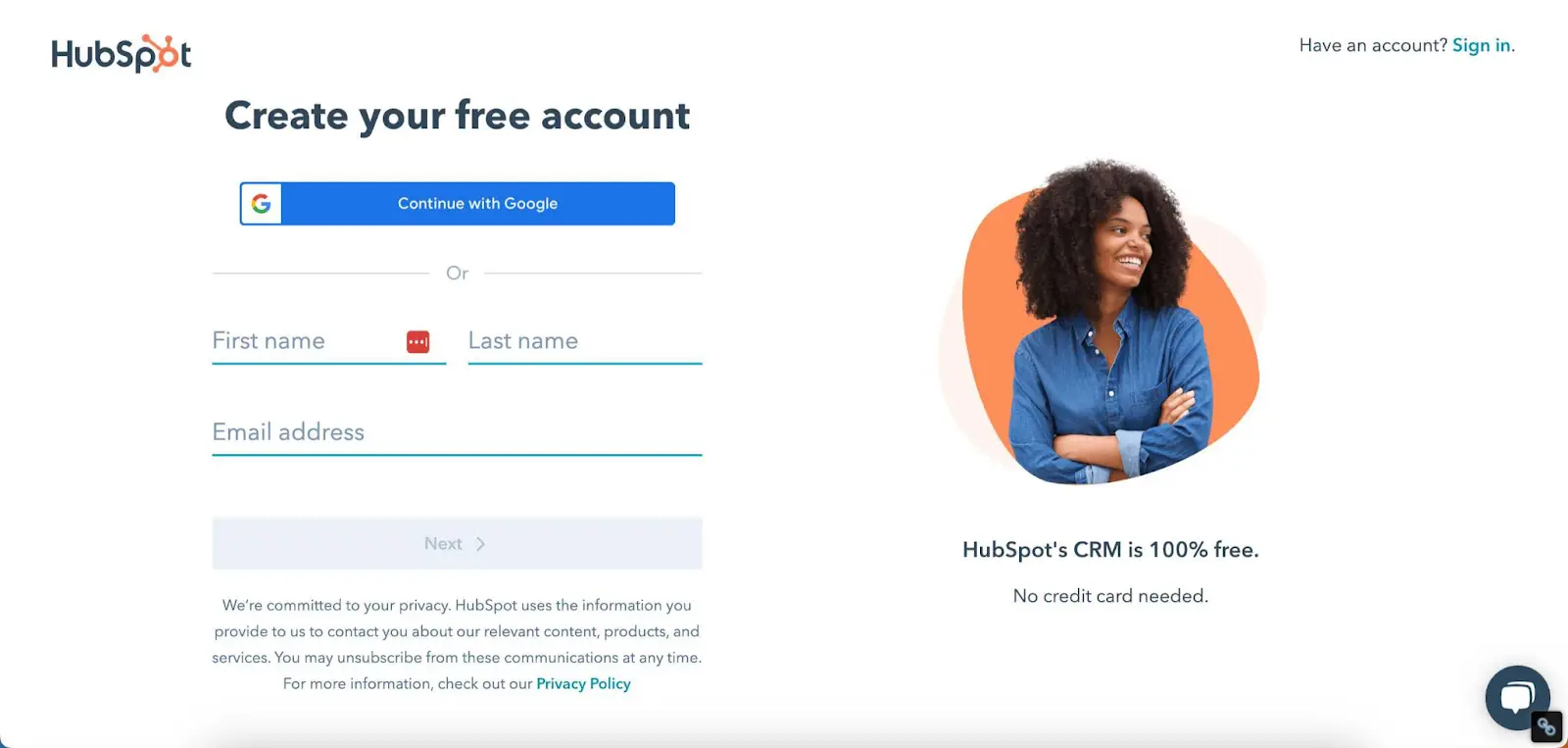
- Visit the HubSpot website and navigate to the “Products” section.
- Click on “Get started” for HubSpot CRM.
- Enter your email address and a strong password to create your free account.
- Fill out your basic information and choose your industry (e.g., Ecommerce).
- You’re all set!
HubSpot will guide you through a quick onboarding process. Or if you run into any issue, we’re always there to help!
Talking about our help, here’s a detailed guide on How To Perform The Basic HubSpot CRM Setup
Navigating the Platform: Your HubSpot CRM Command Center
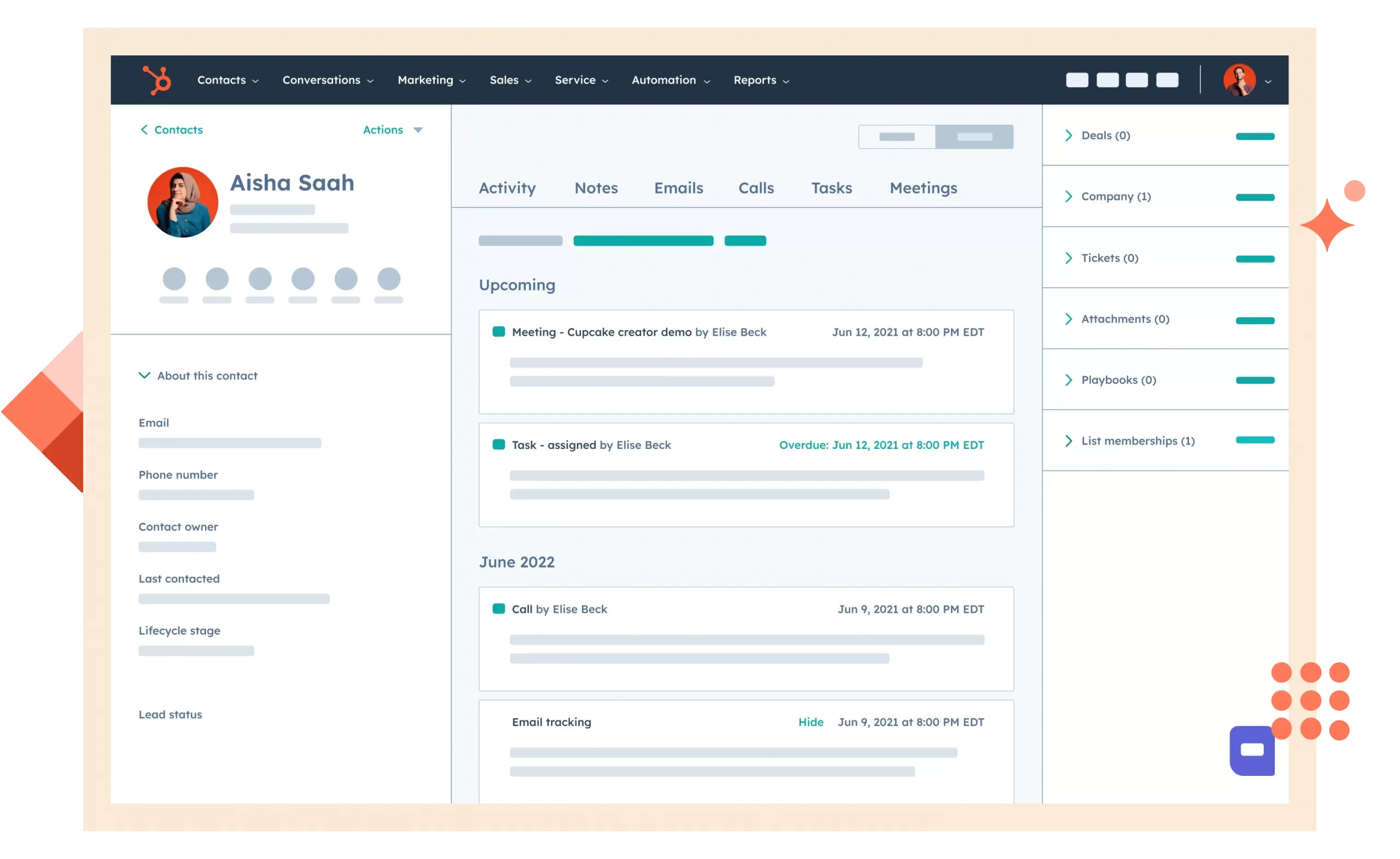
Now that you’re in, let’s familiarize ourselves with the key sections of the HubSpot CRM interface:
- Contacts: This central hub houses all your customer information, including contact details, purchase history, and communication preferences.
- Deals: Manage your sales pipeline within the Deals section. Track deals through various stages (Lead, Opportunity, Close Won/Lost), prioritize high-value prospects, and ensure timely follow-ups.
- Marketing: Unleash the power of HubSpot’s marketing tools to create targeted campaigns, nurture leads, and convert visitors into customers.
- Reports: Gain valuable insights into customer behavior and business performance through comprehensive reporting features. Analyze data, track key metrics (KPIs), and identify trends to optimize your ecommerce strategy.
Data Foundation: Importing and Managing Customer Information
Now that you’re set up with HubSpot Integration for eCommerce, it’s time to populate it with the lifeblood of your business – your customer data!
Here, we’ll explore various import options and delve into the importance of data hygiene.
Data Import Options: Bringing Your Customers In

HubSpot CRM offers several ways to import your existing customer data, making the transition seamless:
- Upload CSV Files: Have your customer information stored in a spreadsheet? No problem!Simply export your data as a CSV file and upload it directly into HubSpot CRM.
- Connect with Email Marketing Platforms: Streamline the process by integrating your existing email marketing platform with HubSpot CRM. This allows for effortless transfer of customer data you’ve already collected.
- Direct Ecommerce Platform Integration: For a truly unified experience, establish a direct connection between your ecommerce platform and HubSpot CRM. This enables automatic data synchronization, ensuring all customer information (think purchase history, contact details) flows seamlessly between platforms.
Data Quality Matters: Keeping Your Information Clean

Just like a well-oiled machine, your CRM thrives on clean and accurate data. Here are some actionable tips for maintaining data hygiene:
- Standardize Data Entry: Establish clear guidelines for how information is entered into the system. This ensures consistency and reduces errors.
- Regular Data Cleansing: Schedule regular reviews of your customer data to identify and remove duplicates, fix inconsistencies, and update outdated information.
- Utilize Data Validation Tools: HubSpot CRM offers built-in tools to help you validate data during the import process. This helps catch errors before they enter your system.
By following these data management best practices, you ensure your HubSpot CRM reflects a clear and accurate picture of your customer base.
This empowers you to make informed decisions, personalize marketing campaigns, and ultimately, build stronger customer relationships.
In the next section, we’ll explore how to connect your ecommerce store to HubSpot CRM, further solidifying your data foundation.
Unifying Your Sales & Ecommerce Ecosystem
Think about a world where your ecommerce store and HubSpot CRM work in perfect harmony. This dream becomes reality with platform integrations!
Here, we’ll explore how to connect popular ecommerce platforms with HubSpot CRM, along with the benefits of creating this unified ecosystem.
Connecting Your Store: Building Bridges with Popular Platforms
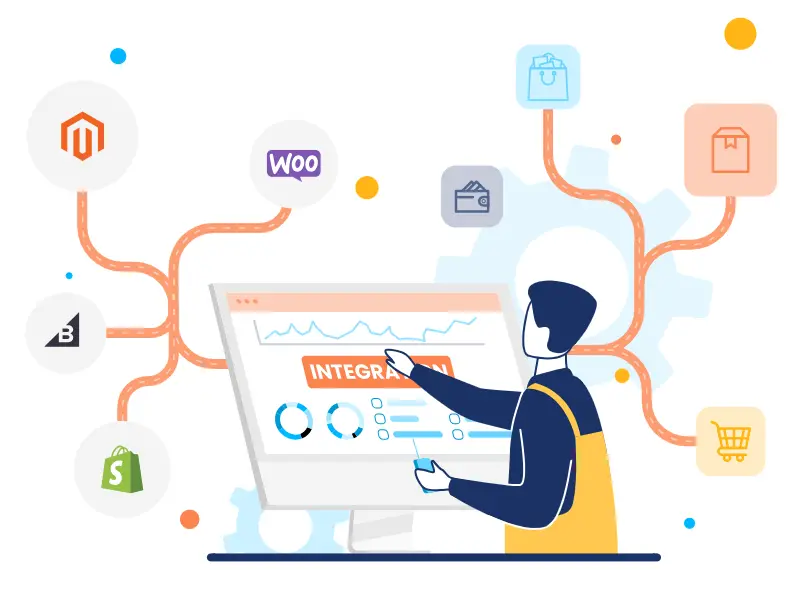
Here’s a glimpse into integrating some of the most popular ecommerce platforms with HubSpot CRM:
Shopline HubSpot Integration
Streamline your ecommerce operations by connecting your Shopline store with HubSpot CRM.
MakeWebBetter provides a seamless Shopline HubSpot Integration app that automates data synchronization between platforms.
This ensures all your customer information, order details, and product data flow effortlessly into HubSpot CRM.
BigCommerce HubSpot Integration
Unify your sales and marketing efforts with a direct connection between your BigCommerce store and HubSpot CRM.
HubSpot offers native BigCommerce integration capabilities.
WooCommerce HubSpot Integration
For those leveraging the power of WooCommerce, there are multiple integration options available.
HubSpot offers a native integration, as well as a variety of third-party solutions.
Talking about third party solutions, we have the right WooCommerce integration for you.
Magento HubSpot Integration
Magento, a robust ecommerce platform, also offers integration with HubSpot CRM.
Third-party solutions can facilitate data synchronization and streamline communication between the two platforms.
FormPay HubSpot Integration
Considering FormPay for your secure and reliable payment processing?
FormPay is a product designed and developed by MakeWebBetter.
Learn More About FormPay: A Secure Payment Processing Solution by MakeWebBetter
Check It Out
MakeWebBetter offers a native FormPay + HubSpot integration that allows you to connect your FormPay account and track payment activity within HubSpot CRM.
This ensures a seamless flow of financial data, providing valuable insights for optimizing your sales funnel.
Benefits of Integration: The Power of a Unified Ecosystem
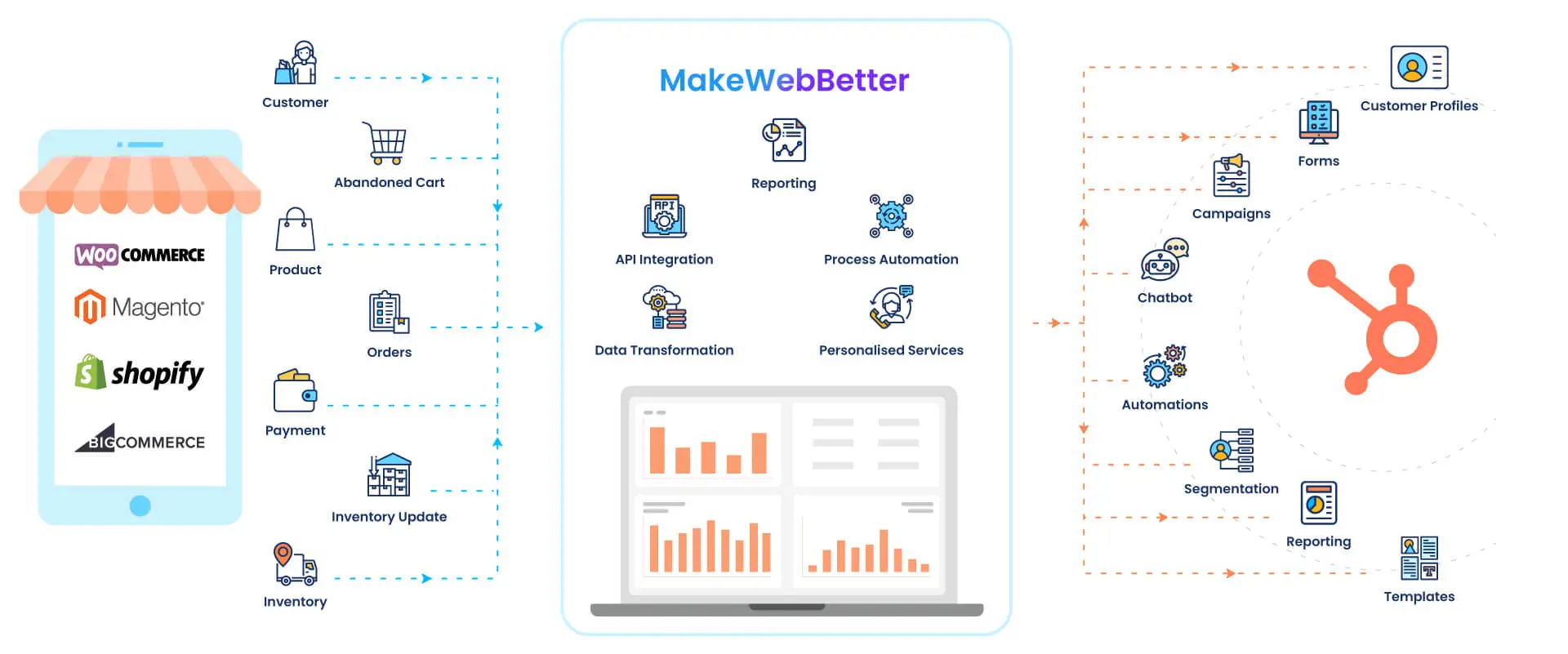
By establishing a connection between your HubSpot integration for ecommerce platform, you unlock a multitude of advantages:
- Automatic Data Synchronization: Say goodbye to manual data entry!Integrations ensure automatic data flow between platforms, keeping your customer information, orders, and product details consistently updated in both systems.
- Holistic View of the Customer Journey: Gain a complete picture of your customer’s journey across all touchpoints. In other words, integrations allow you to track website activity, analyze purchase behavior, and personalize marketing campaigns based on individual customer interactions.
- Improved Sales Pipeline Management: Real-time data insights from your ecommerce platform empower you to effectively manage your sales pipeline within HubSpot integration for eCommerce. So, identify sales opportunities, prioritize high-value prospects, and close deals faster.
A unified HubSpot integration for eCommerce ecosystem fueled by platform integrations empowers you to streamline operations, optimize marketing efforts, and ultimately drive sales growth for your ecommerce business.
Optimizing Your Sales Funnel
HubSpot integration for eCommerce empowers you to optimize your sales funnel, transforming casual visitors into loyal customers. Furthermore, this section will guide you through creating a customized sales pipeline, managing deals effectively, and leveraging smart lists for targeted marketing campaigns.
Sales Pipeline Management: Building Your Conversion Path
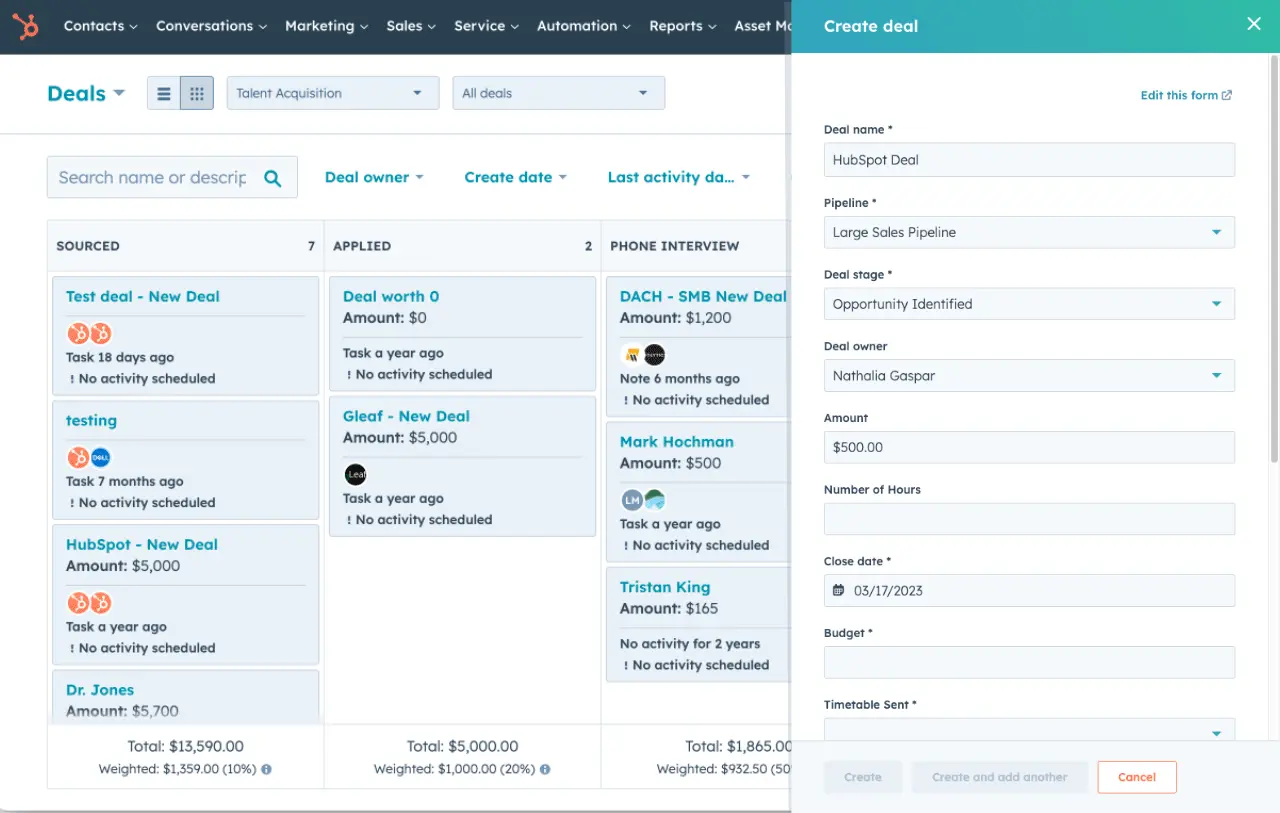
The sales pipeline is the cornerstone of your sales process within HubSpot CRM. That is to say, it visually represents the journey your leads take towards becoming paying customers.
Here’s how to create and customize your sales pipeline:
- Navigate to “Sales” in the HubSpot CRM menu and select “Pipelines.”
- Click on “Create pipeline.”
- Give your pipeline a name that reflects your sales process (e.g., Ecommerce Sales Pipeline).
- HubSpot offers predefined deal stages (Lead, Opportunity, Close Won/Lost). These can be customized to align with your specific ecommerce funnel. For example, consider adding stages like:
- “Product Browsing” to capture website visitors who are actively looking at products.
- “Cart Addition” to identify individuals who have added items to their cart.
- “Cart Abandonment” to flag abandoned carts, allowing you to re-engage these potential customers.
- “Payment Processing” to track orders as they progress through checkout.
Deal Tracking & Prioritization: Keeping Your Eye on the Prize
With your sales pipeline established, let’s delve into managing deals effectively. In other words, each deal within the pipeline represents a potential customer.

So, here’s how to stay on top of your deals:
- Create deals for new leads entering your sales pipeline. HubSpot CRM allows you to associate contact information, notes, and emails with each deal.
- Move deals through the various stages of your pipeline as your leads progress. This visual tracking provides a clear picture of where each potential customer stands in the buying journey.
- Prioritize high-value deals. HubSpot CRM allows you to assign deal weight based on potential revenue. This helps you focus your efforts on the most promising opportunities.
Smart Lists and Segmentation: Targeting the Right Customers
HubSpot CRM’s smart list functionality allows you to create targeted customer segments.
In other words, by applying filters and criteria, you can identify specific groups of customers for personalized marketing campaigns.
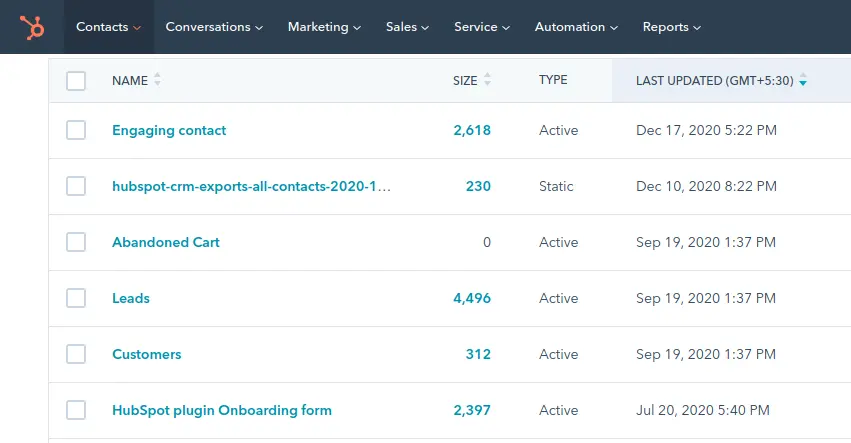
Here are some segmentation examples for your ecommerce business:
- Recent Purchasers: Target recent buyers with exclusive offers or recommendations based on their purchase history.
- Abandoned Cart Users: Re-engage customers who abandoned their carts with personalized email campaigns featuring abandoned cart recovery strategies.
- Inactive Users: Craft targeted campaigns to win back customers who haven’t interacted with your store in a while.
To clarify, by leveraging smart lists and segmentation, you can deliver highly relevant marketing messages, ultimately converting more leads into loyal customers.
Building Lasting Customer Relationships
HubSpot CRM goes beyond sales – it empowers you to build lasting customer relationships. This section dives into creating enriched customer profiles and leveraging personalized communication strategies.
Enriched Customer Profiles: Understanding Your Customers
Detailed customer profiles are the foundation of strong relationships. HubSpot CRM allows you to create comprehensive profiles that go beyond just contact information.
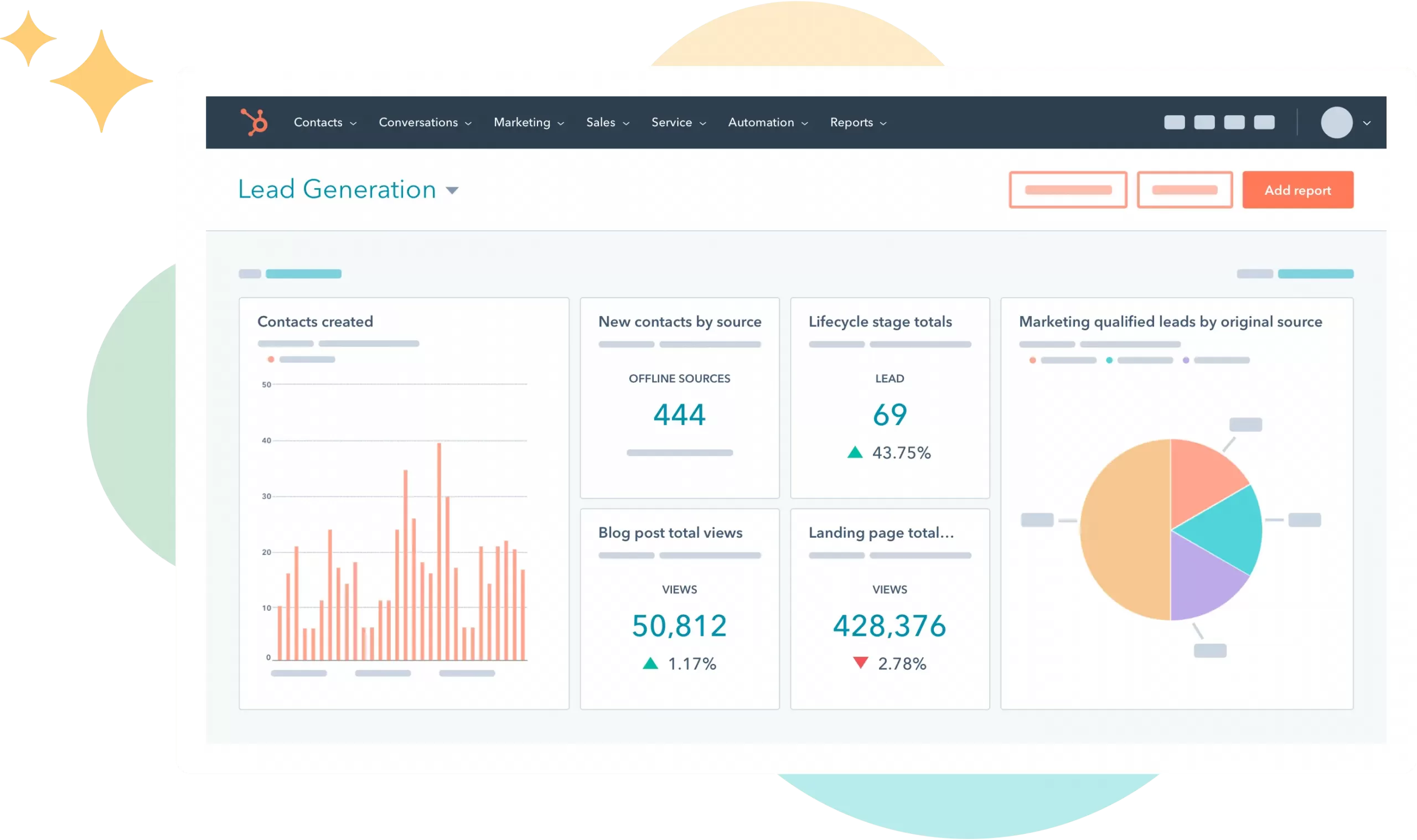
Here’s how to enrich your customer profiles:
- Capture Purchase History and Product Preferences: Track what your customers buy and what interests them. This valuable data informs future marketing efforts.
- Record Communication Channels: Note preferred communication methods (email, phone) for personalized outreach.
- Utilize Custom Fields: HubSpot CRM allows you to create custom fields specific to your business. For example, track loyalty program membership or past customer service interactions.
By gathering this in-depth customer information, you gain valuable insights that fuel HubSpot integration for eCommerce personalization – the key to fostering stronger relationships.
Personalized Communication: The Power of One-to-One Marketing
HubSpot CRM’s email marketing tools transform generic blasts into personalized interactions.
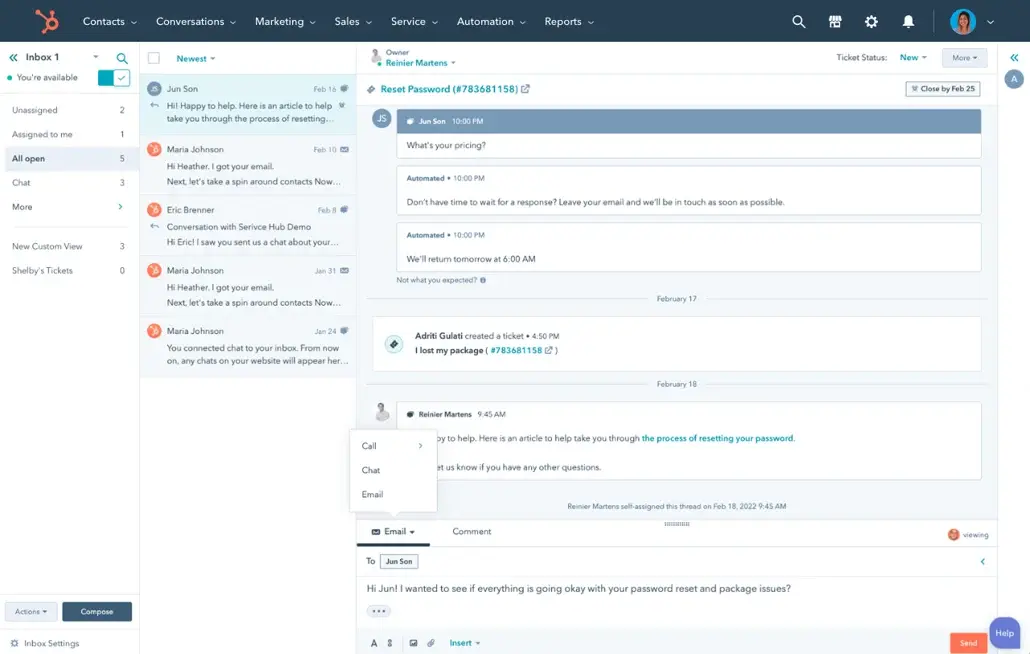
Here’s how to leverage them for powerful results:
- Welcome New Customers with a Warm Embrace: Send automated welcome emails that introduce your brand, showcase popular products, and offer exclusive discounts.
- Design Targeted Campaigns Based on Behavior: Segment your customer base using smart lists and create targeted email campaigns based on purchase history, interests, or browsing activity. That is to say, recommend relevant products, highlight special offers, or provide helpful content – all tailored to their unique needs.
- Automate Engagement with Email Sequences: HubSpot CRM allows you to create automated email sequences triggered by specific customer actions. For example, design an abandoned cart recovery sequence to re-engage customers who left items behind, or set up a post-purchase follow-up series to solicit feedback and encourage repeat business.
- Win Back Dormant Customers: Revive inactive users with personalized win-back campaigns. In other words, offer exclusive discounts or highlight new products that might pique their interest.
So, by personalizing your communication, you build stronger relationships, increase customer engagement, and ultimately drive sales growth.
Data-Driven Decisions: Unleashing the Power of Analytics
HubSpot CRM isn’t just about collecting customer data; it’s about transforming that data into actionable insights that fuel smarter business decisions.
This section will guide you through leveraging HubSpot’s powerful reporting features to analyze customer behavior, track KPIs, and ultimately optimize your HubSpot integration for eCommerce strategy.
Actionable Insights: Unearthing the Gems in Your Data
HubSpot CRM empowers you to delve deep into your customer data, uncovering valuable insights that inform your marketing and sales efforts.
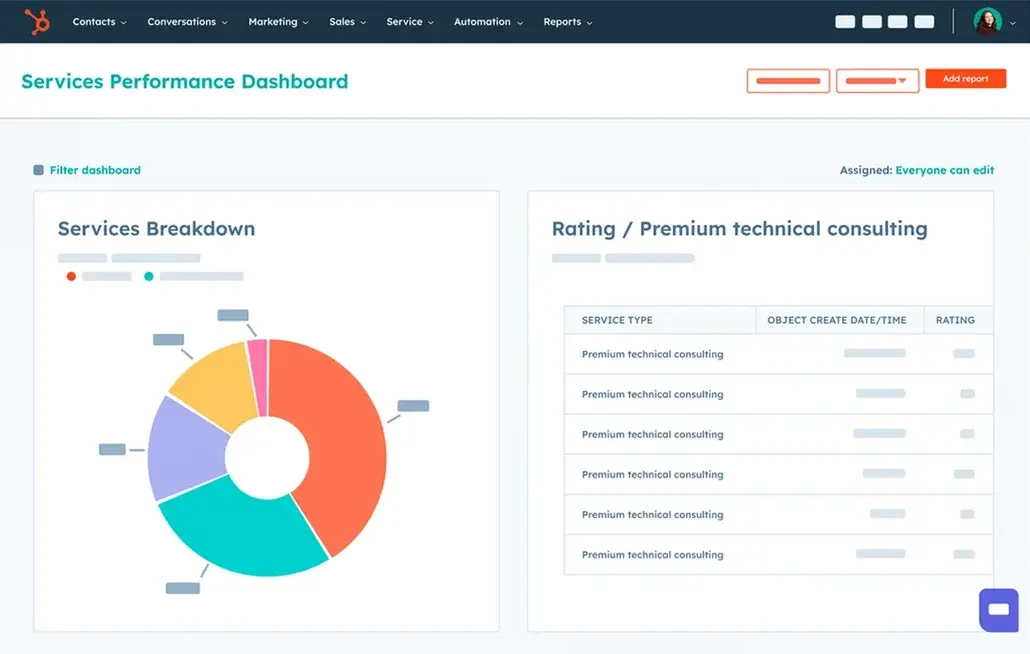
Here’s how to get started:
- Analyze Customer Behavior and Buying Patterns: Gain a deeper understanding of your customer base. Identify popular product categories, preferred browsing habits, and common purchase triggers. In other words, this knowledge allows you to tailor your product offerings and marketing campaigns to better resonate with your target audience.
- Track Key Performance Indicators (KPIs): KPIs are the metrics that matter most to your business. HubSpot CRM allows you to track essential ecommerce KPIs like conversion rates (visitor to customer), average order value, and customer lifetime value (CLTV). That is to say, monitoring these metrics helps you gauge the effectiveness of your marketing efforts and identify areas for improvement.
- Identify Sales Trends and Make Data-Driven Decisions: HubSpot CRM’s reporting features allow you to visualize sales trends over time. Analyze sales pipeline performance, identify top-performing products or sales channels, and pinpoint potential bottlenecks. Therefore, with these data-driven insights in hand, you can make informed decisions to optimize your sales funnel and maximize revenue potential.
Examples of Data-Driven Decisions
- Based on customer behavior reports, you discover a surge in demand for a specific product category. Moreover, you can adjust your marketing campaigns to highlight these products and capitalize on the trend.
- Your reports reveal a significant drop in conversion rates on mobile devices. In other words, this insight prompts you to optimize your mobile website for a smoother user experience, potentially leading to increased conversions.
- Analyzing CLTV allows you to identify your most valuable customer segments. Therefore, you can then tailor targeted marketing campaigns to nurture these high-value customers and encourage repeat business.
Furthermore, by leveraging the power of data analytics within HubSpot CRM, you gain a deeper understanding of your customers and business performance.
That is to say, this empowers you to make data-driven decisions that optimize your marketing efforts, improve sales efficiency, and ultimately drive sustainable growth for your ecommerce business.
So, this concludes our comprehensive guide to getting started with HubSpot CRM for your ecommerce business.
By following these steps and leveraging the platform’s powerful tools, you’ll be well on your way to building stronger customer relationships, optimizing your sales funnel, and achieving long-term success.
Continuous Improvement: Resources and Advanced Strategies
HubSpot CRM is a powerful platform, but the journey to ecommerce mastery is an ongoing process.
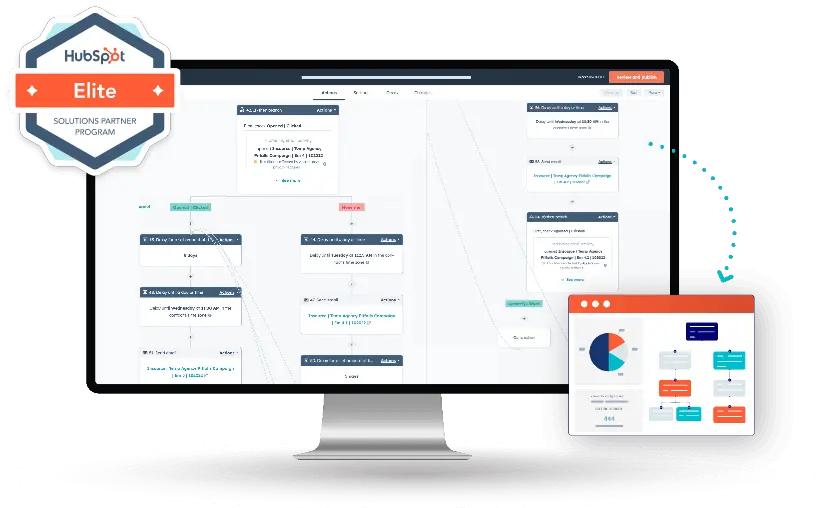
Above all, here are some resources to help you continuously improve and unlock the platform’s full potential:
HubSpot Academy: Your Gateway to Expertise
HubSpot Academy offers a treasure trove of free online courses and certifications designed to transform you into a HubSpot CRM expert.
Moreover, these courses cover everything from the fundamentals to advanced functionalities, empowering you to leverage the platform to its fullest capacity.
So, explore the academy and embark on a learning journey that will elevate your ecommerce marketing and sales strategies.
HubSpot App Marketplace: A World of Integrations Awaits
HubSpot CRM integrates seamlessly with a vast array of third-party apps available on the HubSpot App Marketplace.
Moreover, this marketplace allows you to extend the functionality of your CRM and tailor it to your specific needs.
So, here are some examples of valuable HubSpot integration for eCommerce businesses:
- Live Chat for Enhanced Customer Support: Provide real-time assistance to website visitors and answer their questions directly through a live chat interface. This can significantly improve customer satisfaction and conversion rates.
- Loyalty Program Management: Integrate a loyalty program management app to reward repeat customers and incentivize them to keep coming back for more. That is to say, boost customer engagement and brand loyalty with a well-designed loyalty program.
The Road to Success Starts Now
By implementing the strategies outlined in this HubSpot integration for eCommerce guide and leveraging the resources available, you’re well on your way to ecommerce success with HubSpot CRM.
So remember, the key to unlocking the platform’s true potential lies in continuous learning and exploration.
MakeWebBetter: Your Partner in Ecommerce Growth
Above all, as you embark on this exciting journey, MakeWebBetter is here to support you every step of the way. We offer a comprehensive suite of services, including:
- HubSpot Onboarding and Implementation: Our team of experts can help you set up HubSpot CRM seamlessly and ensure it aligns perfectly with your business goals.
- Advanced Strategy Development: Looking to take your ecommerce strategy to the next level? We can help you develop and implement advanced marketing automation campaigns, create targeted customer segments, and unlock the full potential of HubSpot CRM’s analytics features.
- Ongoing Support and Optimization: The HubSpot integration for eCommerce landscape is constantly evolving. That is to say, MakeWebBetter provides ongoing support to ensure your HubSpot CRM setup remains optimized and delivers exceptional results over time.
Ready to take your ecommerce business to new heights?
Contact MakeWebBetter today and schedule a free consultation to discuss your unique needs.

